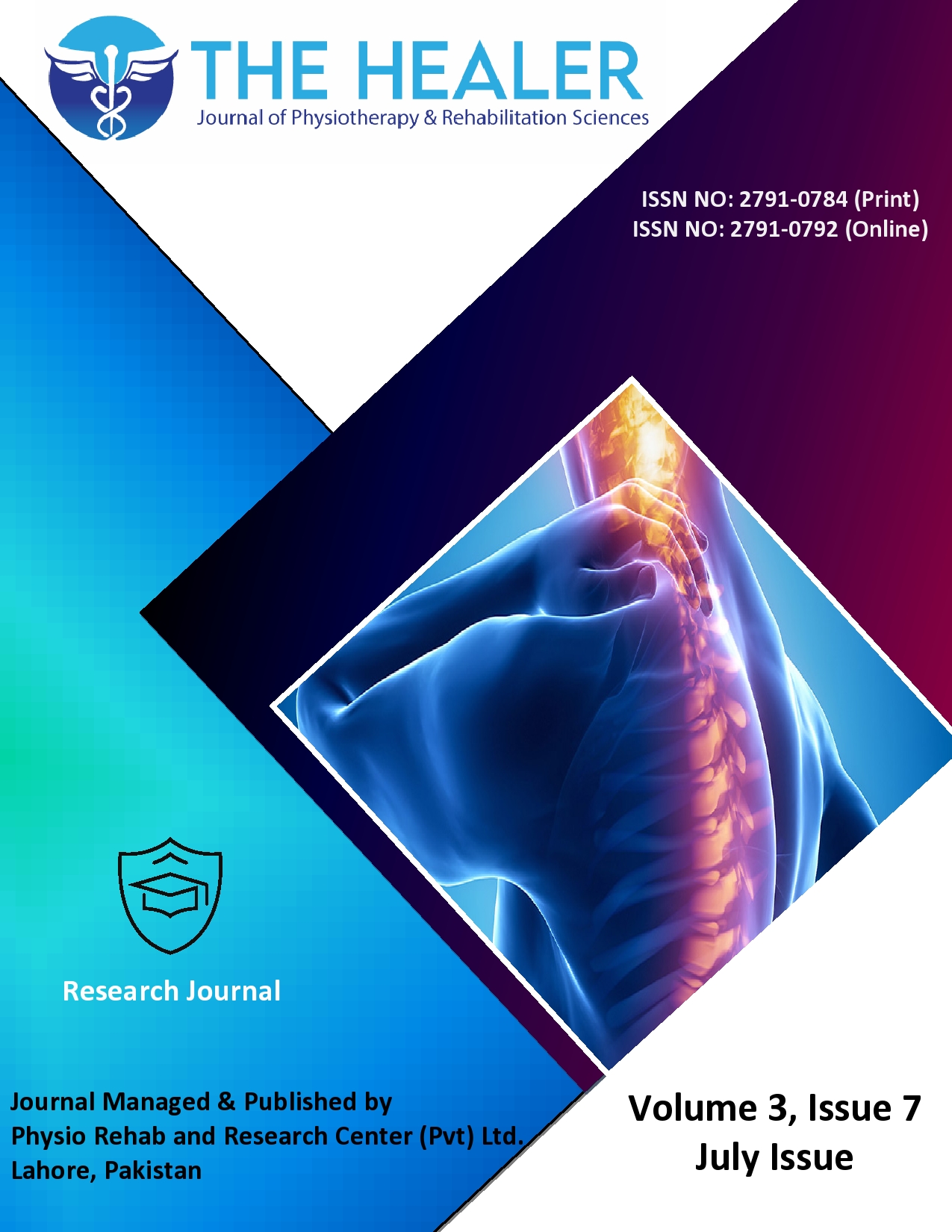Frequency of Meralgia Paresthetica during Third Trimester of Pregnancy: Cross-sectional Study
Meralgia Paresthetica during Pregnancy
DOI:
https://doi.org/10.55735/hjprs.v3i7.181Keywords:
third trimester, meralgia paresthetica, mononeuropathy, pregnancyAbstract
Background: Meralgia paresthetica is one of the most common painful mononeuropathy among pregnant females, characterized by pain sensation on the anterolateral aspect of the thigh. It is the entrapment of lateral femoral cutaneous nerve, which causes a tingling and burning type sensation in the area undersupplied by this nerve. Objective: To determine the frequency of meralgia paresthetica during the third trimester of pregancy. Methods: This descriptive cross-sectional study was conducted at Gurkhi Trust Teaching Hospital and Jinnah Hospital Lahore between June to December 2020 after receiving permission from the Ethics Committee of Lahore College of Physical Therapy. The sample size of 63 patients was calculated through the WHO calculator. These patients were enrolled in the study through non-probability convenient sampling. Females who were in their third trimester and had a complaint of discomfort around the hip and thigh were included in the study. Furthermore, females who reported a history of lumbar spine and groin surgery, chronic back pain, traumatic injury of hip joint, fracture, and dislocation were excluded from the study. A written and verbal consent was taken from each patient and a detailed questionnaire was filled. The questionnaire included demographic variables like age and body mass index, neuropathic pain scale and pelvic compression test. Data was analyzed by using SPSS version 26 and results were described in frequency and percentage. Results: Out of 63 participants total discriminant function scale was in the neuropathic range in 14(22.2%) participants. The total score was in the neuropathic range in 15(76.3%) and non-neuropathic range in 48(76.2%) participants. Out of 63 participants pelvic compression test was positive in 15(23.8%) and negative in 48(76.2%) participants. Overall results showed that out of 63 participants, 13 were those who had total discriminant function scale and total score in the neuropathic range along with a positive pelvic compression test showing the frequency of meralgia paresthetica to be 20.63% in pregnant females during their third trimester. Conclusion: This study concluded that the frequency of meralgia paresthetica is low in females during their third trimester of pregnancy.
References
den Brave PS, Nunes SEV, Bronkhorst MWJJoot. Anatomical variations of the lateral femoral cutaneous nerve and iatrogenic injury after autologous bone grafting from the iliac crest. 2015; 29(12): 549-53.
Solomons JNT, Sagir A, Yazdi CJCP, Reports H. Meralgia Paresthetica. 2022; 26(7): 525-31.
Charipova K, Gress K, Berger AA, et al. A comprehensive review and update of post-surgical cutaneous nerve entrapment. 2021; 25: 1-8.
Gooding MS, Evangelista V, Pereira LJO, survey g. Carpal tunnel syndrome and meralgia paresthetica in pregnancy. 2020; 75(2): 121-6.
Weng W-C, Wei Y-C, Huang W-Y, Chien Y-Y, Peng T-I, Wu C-LJJoCN. Risk factor analysis for meralgia paresthetica: A hospital-based study in Taiwan. 2017; 43: 192-5.
Coffey R, Gupta V. Meralgia Paresthetica. StatPearls [Internet]: StatPearls Publishing; 2023.
Parisi TJ, Mandrekar J, Dyck PJB, Klein CJJN. Meralgia paresthetica: relation to obesity, advanced age, and diabetes mellitus. 2011; 77(16): 1538-42.
Cheatham SW, Kolber MJ, Salamh PAJIjospt. Meralgia paresthetica: a review of the literature. 2013; 8(6): 883.
Ata AMJPP. Ultrasound-guided diagnosis and treatment of meralgia paresthetica. 2016; 19: E667-E9.
Harney D, Patijn JJPM. Meralgia paresthetica: diagnosis and management strategies. 2007; 8(8): 669-77.
Kahn SB, Xu RY. Musculoskeletal sports and spine disorders: a comprehensive guide: Springer; 2018.
Benzon HTJRa, medicine p. The neuropathic pain scales. 2005; 30(5): 417.
Shimizu SJN. A novel approach to the diagnosis and management of meralgia paresthetica. 2008; 63(4): E820.
Van Slobbe A, Bohnen A, Bernsen R, Koes B, Bierma-Zeinstra SJJon. Incidence rates and determinants in meralgia paresthetica in general practice. 2004; 251: 294-7.
Rosier C, Camdessanché J-PJRN. Neuropathy and pregnancy: an overview. 2021; 177(3): 220-4.
Mondelli M, Rossi S, Romano CJAns. Body mass index in meralgia paresthetica: a case–control study. 2007; 116(2): 118-23.
Ercan S, Ataizi ZS, Ertilav KJTN. The correlation of meralgia paresthetica and spinal surgery in prone position. 2020; 30(1): 89-93.

Downloads
Published
How to Cite
License
Copyright (c) 2023 The Healer Journal of Physiotherapy and Rehabilitation Sciences

This work is licensed under a Creative Commons Attribution 4.0 International License.
CC BY


